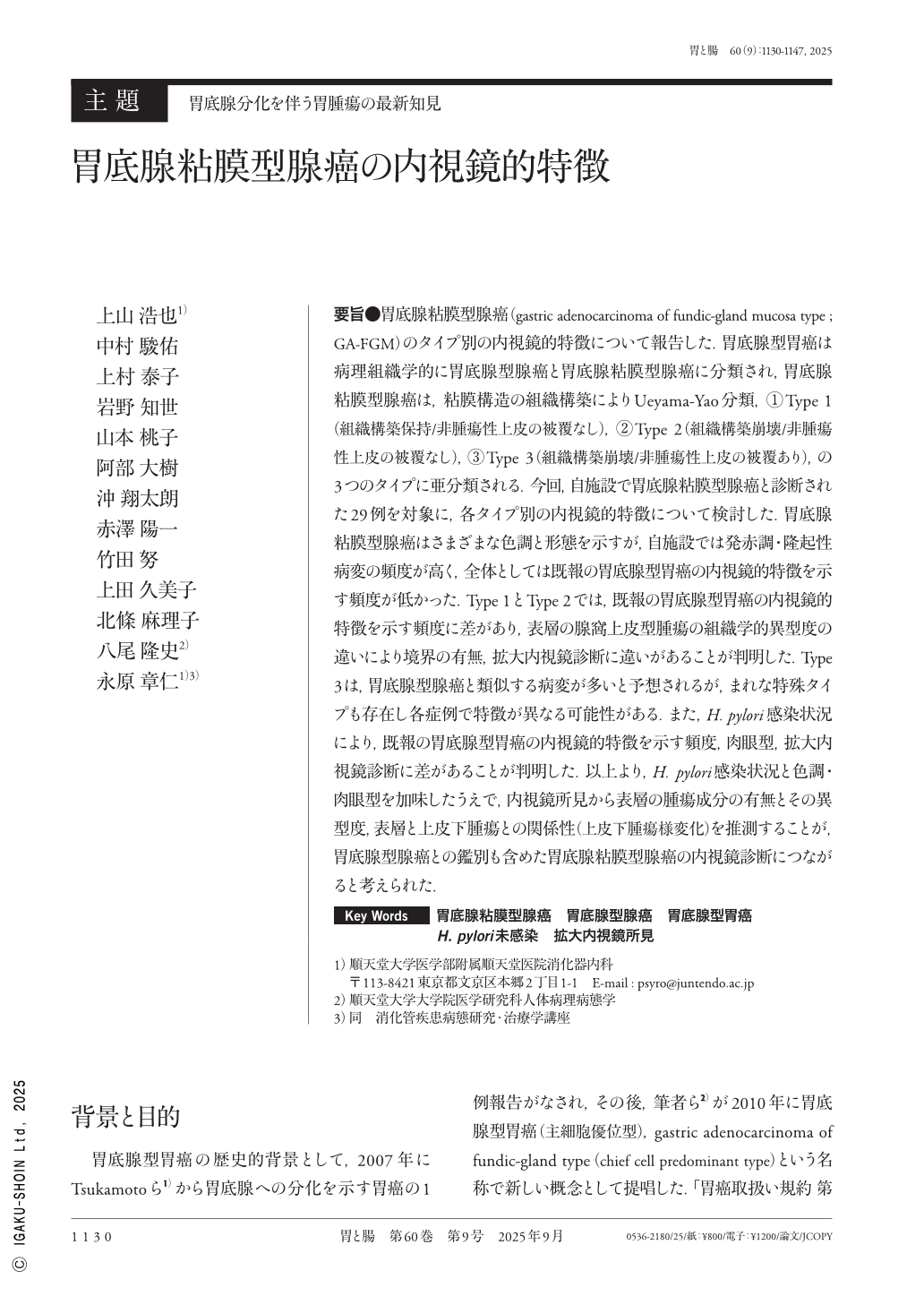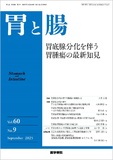Japanese
English
- 有料閲覧
- Abstract 文献概要
- 1ページ目 Look Inside
- 参考文献 Reference
要旨●胃底腺粘膜型腺癌(gastric adenocarcinoma of fundic-gland mucosa type ; GA-FGM)のタイプ別の内視鏡的特徴について報告した.胃底腺型胃癌は病理組織学的に胃底腺型腺癌と胃底腺粘膜型腺癌に分類され,胃底腺粘膜型腺癌は,粘膜構造の組織構築によりUeyama-Yao分類,①Type 1(組織構築保持/非腫瘍性上皮の被覆なし),②Type 2(組織構築崩壊/非腫瘍性上皮の被覆なし),③Type 3(組織構築崩壊/非腫瘍性上皮の被覆あり),の3つのタイプに亜分類される.今回,自施設で胃底腺粘膜型腺癌と診断された29例を対象に,各タイプ別の内視鏡的特徴について検討した.胃底腺粘膜型腺癌はさまざまな色調と形態を示すが,自施設では発赤調・隆起性病変の頻度が高く,全体としては既報の胃底腺型胃癌の内視鏡的特徴を示す頻度が低かった.Type 1とType 2では,既報の胃底腺型胃癌の内視鏡的特徴を示す頻度に差があり,表層の腺窩上皮型腫瘍の組織学的異型度の違いにより境界の有無,拡大内視鏡診断に違いがあることが判明した.Type 3は,胃底腺型腺癌と類似する病変が多いと予想されるが,まれな特殊タイプも存在し各症例で特徴が異なる可能性がある.また,H. pylori感染状況により,既報の胃底腺型胃癌の内視鏡的特徴を示す頻度,肉眼型,拡大内視鏡診断に差があることが判明した.以上より,H. pylori感染状況と色調・肉眼型を加味したうえで,内視鏡所見から表層の腫瘍成分の有無とその異型度,表層と上皮下腫瘍との関係性(上皮下腫瘍様変化)を推測することが,胃底腺型腺癌との鑑別も含めた胃底腺粘膜型腺癌の内視鏡診断につながると考えられた.
We investigated the endoscopic characteristics of gastric adenocarcinoma of fundic-gland mucosa type(GA-FGM). Histopathologically, the gastric epithelial neoplasm of fundic-gland mucosa lineage(GEN-FGML)can be classified into gastric adenocarcinoma of fundic-gland type(GA-FG)and GA-FGM. GA-FGM is further categorized into the following three subtypes according to the architectural structure of the mucosa, based on the Ueyama-Yao classification:(1) Type 1(organized with exposure type),(2) Type 2(disorganized with exposure type), and(3) Type 3(disorganized with non-exposure type). In the present study, we examined the endoscopic features of each subtype in 29 GA-FGM cases at our institution. Although GA-FGM exhibits various colors and morphologies, reddish and elevated lesions were frequently observed in our cohort. Overall, the previously reported endoscopic features of GA-FG were rarely observed in our cases. Between the Type 1 and 2 cases, differences were noted in the frequency of typical endoscopic features, which appeared to be correlated with the differences in the histological atypia of the surface foveolar-type tumor component. These differences affected the visibility of the lesion boundaries and magnifying endoscopic findings. Type 3 lesions are expected to resemble GA-FG, but rare and distinct variants may also exist, suggesting that individual cases may present with unique features. Furthermore, the Helicobacter pylori infection status influenced the frequency of typical endoscopic features, macroscopic appearance, and magnifying endoscopic findings. Based on these results, we concluded that determining the H. pylori infection status along with lesion color and macroscopic type can aid in the endoscopic diagnosis of GA-FGM. This approach enables the prediction of the presence and degree of atypia in the surface tumor component, as well as the relationship between the surface and underlying subepithelial lesion(subepithelial tumor-like changes), thereby facilitating differentiation from GA-FG.

Copyright © 2025, Igaku-Shoin Ltd. All rights reserved.


